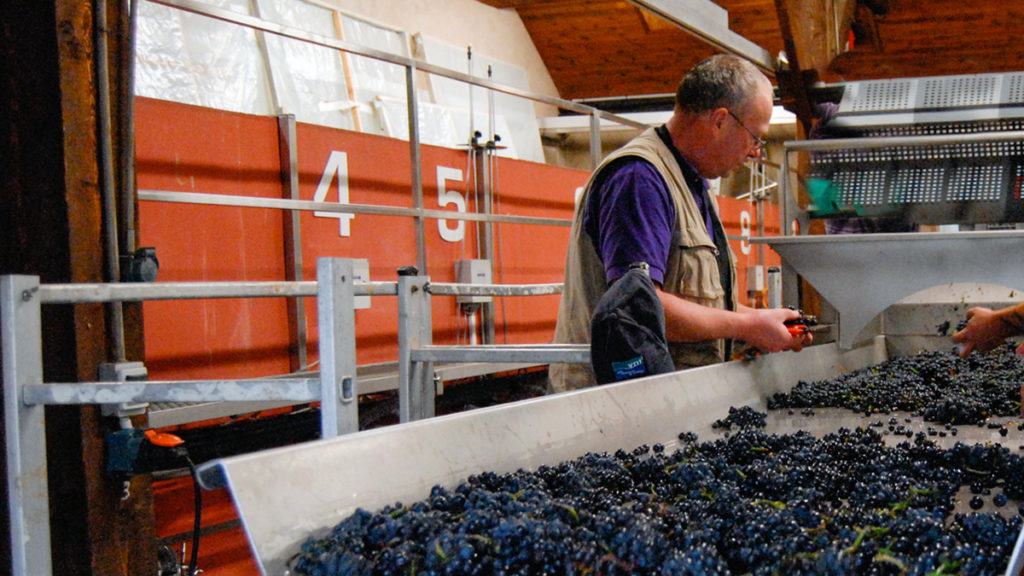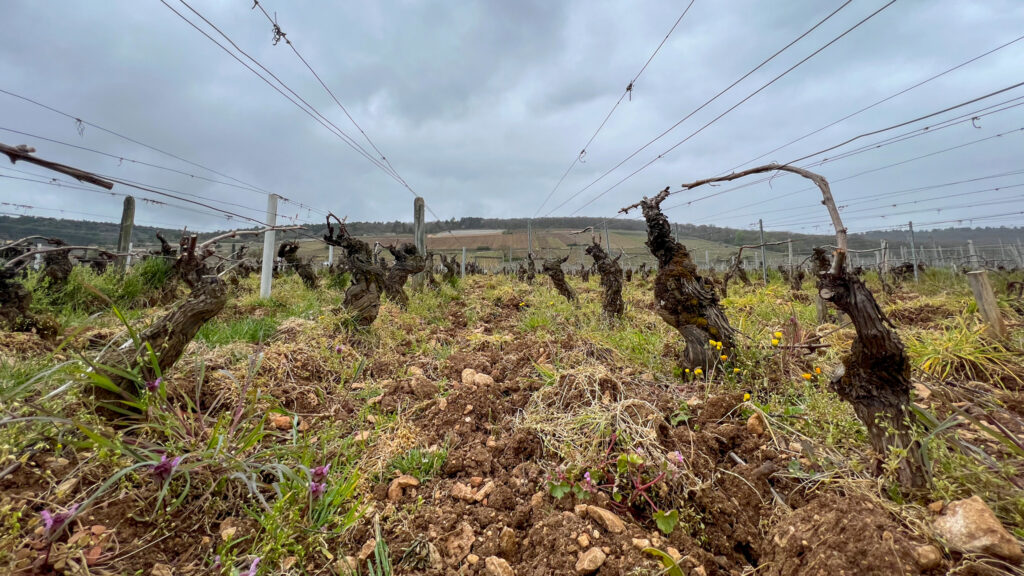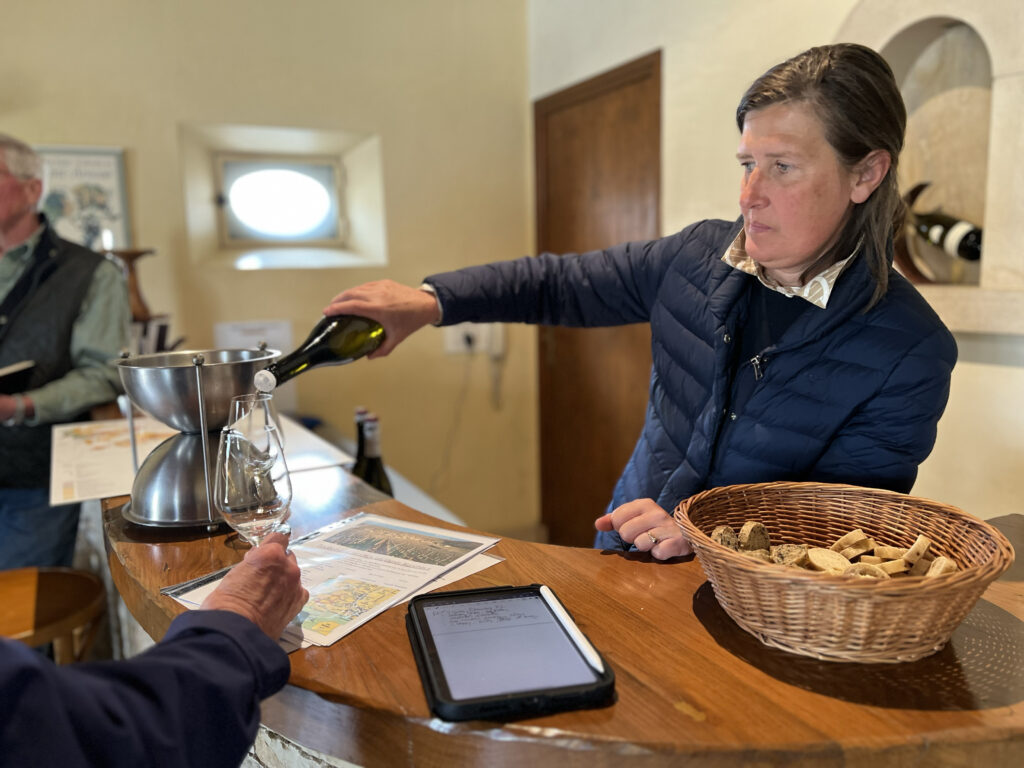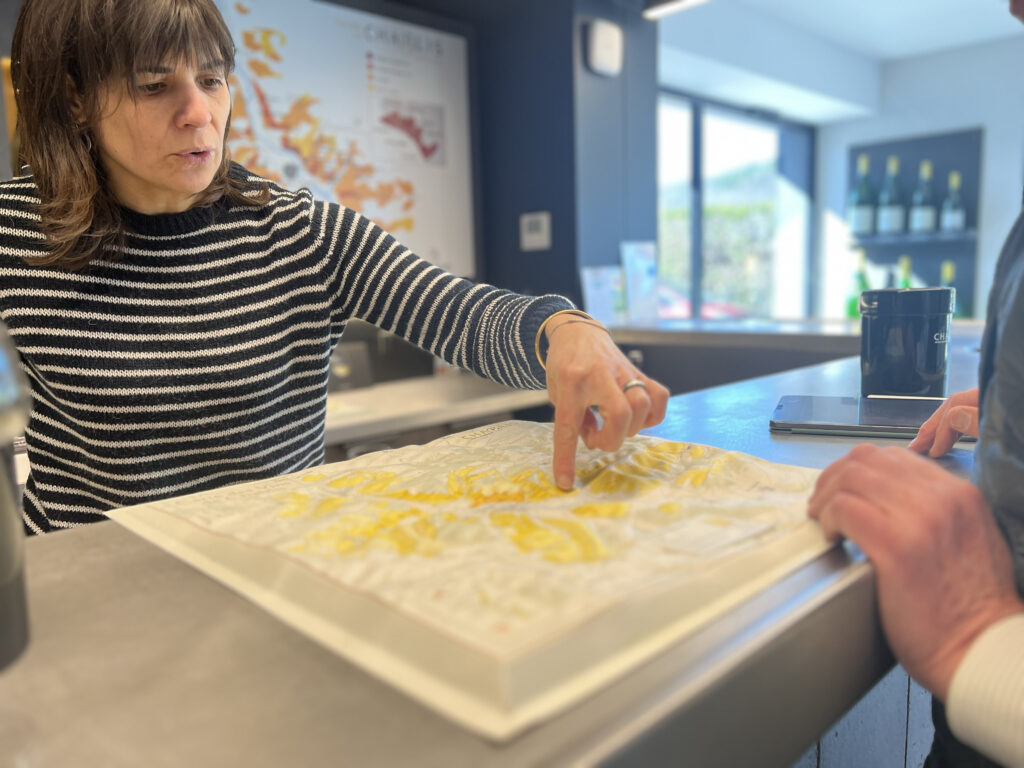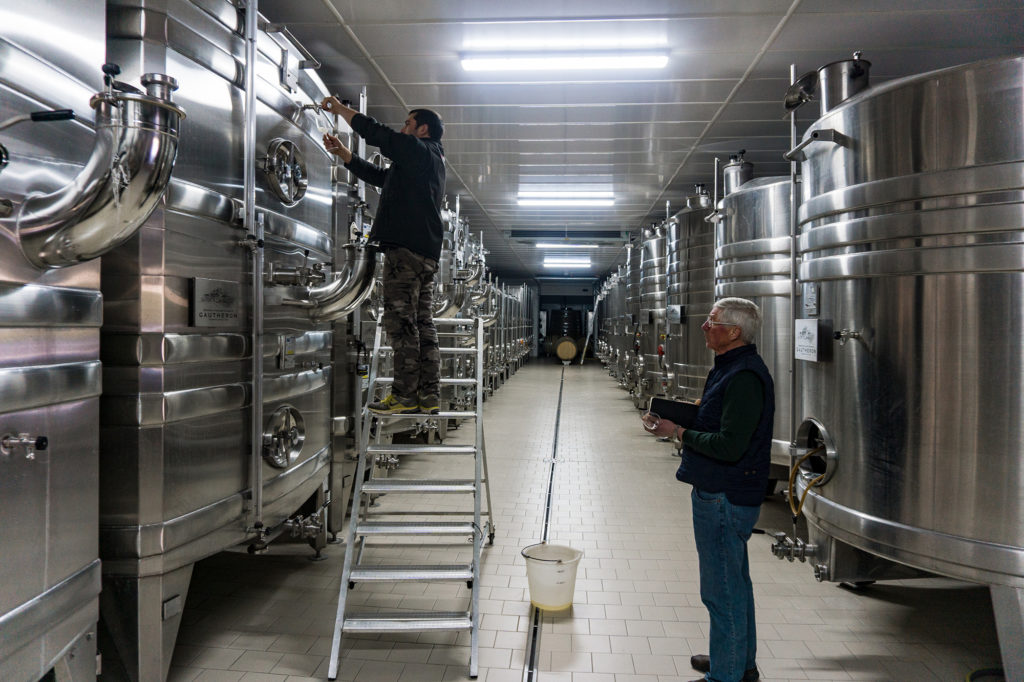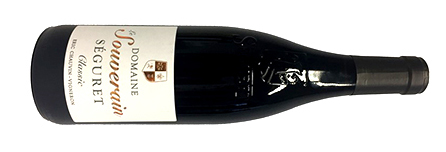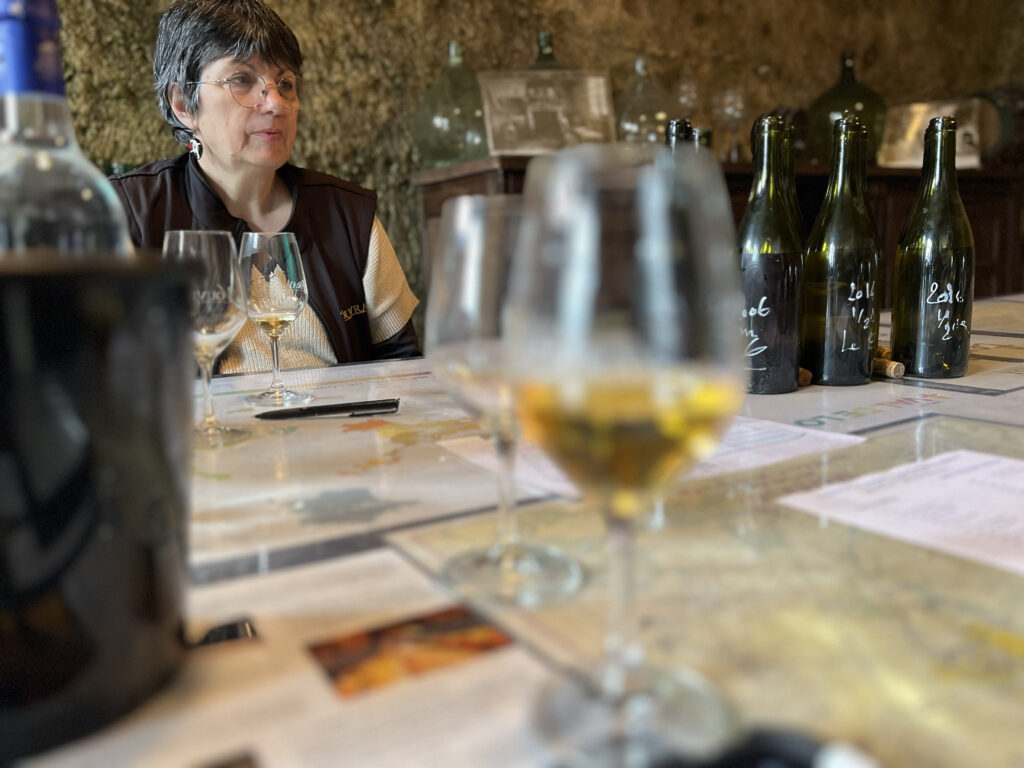This Futures offering comes just after our March visit to France. It’s always reenergizing for us to trek through the places where our wine is made, to see winemakers who have become friends and partners, and to get a hands-on feel for the results of the latest growing season. But by the end of this visit we were fielding questions we could not answer about our government’s plans for the future of trade between our countries. There is little use in reviewing the uncertainties of the tariff dispute today, but like all of our previous visits this trip reaffirmed a fact we feel certain about: the great wines of France are inherently reflective of the place in which they are made and cannot be duplicated in other places. Put differently, if you want to experience the magic of a great red Burgundy in the United States, you have to buy it in France and bring it here. Which is exactly what we’ll continue to do. Wine has been made for a thousand years in Burgundy, and will continue to be made long after we’re gone. French winemakers are in the habit of taking the long view – they plant vines their grandchildren will harvest, they treat their soils like living organisms in need of care and good health, they craft wines that won’t hit peak maturity in their lifetimes. We’ll do our best to match their quiet stoicism, and hold steady to our mission: to find and import thoughtful wines that reflect their origin, prioritizing value, meticulous transport, and, of course, flat-out delicious bottles. But enough about the uniqueness of the great wines of France. As always, we are excited to discover new vintages and new wines that are full of character, that can complement a meal or enliven a moment, or that change over time in ways that are simply delightful. This offering includes red Burgundy from the heart of the Côte d’Or, white Burgundy from an hour to the north and from an hour to the south, along with wine from the Côte Chalonnaise, the southern Rhône, and the Loire Valley. As always, our goal is to propose wines for every taste and budget, and we hope you’ll find something of interest in this offering’s wide range of geography and prices. If you do, please be sure to submit your orders, in case or half-case lots, by the Order Deadline of Sunday, April 20, 2025. We will place orders for the wine immediately thereafter. JUMP TO PRODUCER
Amiot
Vessigaud
Gautheron
Ragot
Souverain
Fontainerie
Rosés
April Futures
Order Deadline: 4/20
Domaine Amiot et fils
Morey-St-Denis, Burgundy
Léon Amiot is first and foremost a farmer. A cheerful twentysomething with a quick smile and friendly demeanor, he’s most animated when talking about his vines. He has traveled the world gaining extensive viticultural experience, and has brought real energy and renewed focus to his family’s tiny 5-hectare gem of an estate in Morey-St-Denis. He’s officially organic as of this year, but has already started the process of biodynamic certification. He has abandoned herbicides, planted cover crops, and this year begins an agroforestry project in the name of vineyard biodiversity. Everything at the new Domaine Amiot is done with care and precision, with the health and wellbeing of the vines as their north star. His father Jean-Louis may quietly roll his eyes when Léon stops the pruning mid-way through to await “a more favorable moon,” but it’s Léon driving the ship today. And with four vintages under his belt, the transformation is hard to write off as luck. Amiot’s 2023s are his best vintage to date. They’re serious red Burgundies, expertly constructed with layers of perfectly balanced fruit over a sturdy, refined tannic backbone. We think they will age with ease: the village should drink well later this year, and the premier crus beginning in a year or two. But none of them was easy to spit out at our tasting last month, and for those with a taste for young red Burgundies most will be delightful from the start. Amiot’s Bourgogne rouge is always a favorite, and nearly always sells out through Futures – Chantal (Léon’s mère and office manager) mentioned there was more to go around this year given the large crop, and we’ll order all we can, but it’s still likely to sell out. It’s classic and lovely, with pure wild cherry fruit in the nose and refined pinot tannins. In the mouth it’s charming and juicy, with intense dark fruits and a fresh, crackling texture. It’s also a bargain. At the village level, Amiot’s Morey-St-Denis was gorgeous this year. A blend of eight parcels across the town, this is truly an appellation-wide cuvée, showing the detail and elegance of classic Morey-St-Denis. The nose is very floral, with dried roses and violets; the mouth is clean and well built, with fine tannins all perfectly coated in attractive young fruit. Burghound was a fan as well, citing “various dark berries and earth” in the nose and “fine volume and richness along with an appealing sense of energy” in the mouth. Léon farms vines in a handful of premier cru appellations, but we’ve chosen two as our favorites this year. First, Morey-St-Denis 1er cru “Aux Charmes.” This is the northernmost vineyard in Morey-St-Denis, and sits on the border with Charmes-Chambertin, a Gevrey-Chambertin Grand Cru. This is a noticeable upgrade in intensity from the village-level Morey, with more time in barrel, more length, and more concentration of flavor. But the charming silky quality for which “Charmes” is known is there in spades, with elegant notes of earth, cassis, and smoke. The classic, chiseled character of Morey-St-Denis is below the surface here too, and the combination is enticing. Burghound found it “succulent, round and seductively textured,” with a “velvety mid-palate.” This is an impressive wine this year, and we expect it to drink well for a long time. At the opposite end of the appellation, abutting the Clos de Tart and Bonnes Mares Grand Crus, lies Morey-St-Denis 1er cru “Ruchots,” most writers’ pick for the best premier cru in the town. This was a real stunner this year, very ripe and expressive with loads of lush, inky fruit. It’s got the extraction and length to match. Léon’s vines here cover a wide swath of the terroir within the vineyard, and he credits the diversity of soils with the complexity of the wine. He’s able to blend elegant juice from up-slope stony sectors with rich juice from down-slope clay-rich soils; and the resulting wine has nearly unmatched complexity for its level. We poured the 2019 Ruchots at a dinner earlier this year with far fancier wines, and it stole the show. An impressive wine from a special plot. Back on the north end of town and just over the border into Gevrey-Chambertin lies the famous premier cru “Combottes,” surrounded on all sides by no fewer than five Grand Cru vineyards. Amiot’s plot here always produces near-Grand Cru level wine, and 2023 is no exception. The nose is deep and darkly floral, with Gevrey’s classic marriage of rusticity and power. The mouth is rich and impeccably balanced, with a finish that seems to go on forever. The 2023 shows the wine’s typical density but with perhaps a bit more elegance and polish than usual. This is not one to open in the near term – Burghound, who labeled it “outstanding,” awarded 90-93 points, and found it “impressively long,” suggested at least eight years of patience. We think you could get away with five, but shouldn’t be in a rush. And finally, Amiot’s Clos de la Roche is every inch a Grand Cru. This too is one for the back of the cellar, as it’s built to reward patience. The nose is inky and gorgeous with wild strawberries, toast, and plums. The mouth is like three wines condensed into one, with exceptional concentration and depth but not an ounce of heaviness. Burghound found it “super-sleek and tautly muscular,” and counseled a decade of patience – and this time we agree. Anyone with the time and cellar space will be handsomely rewarded.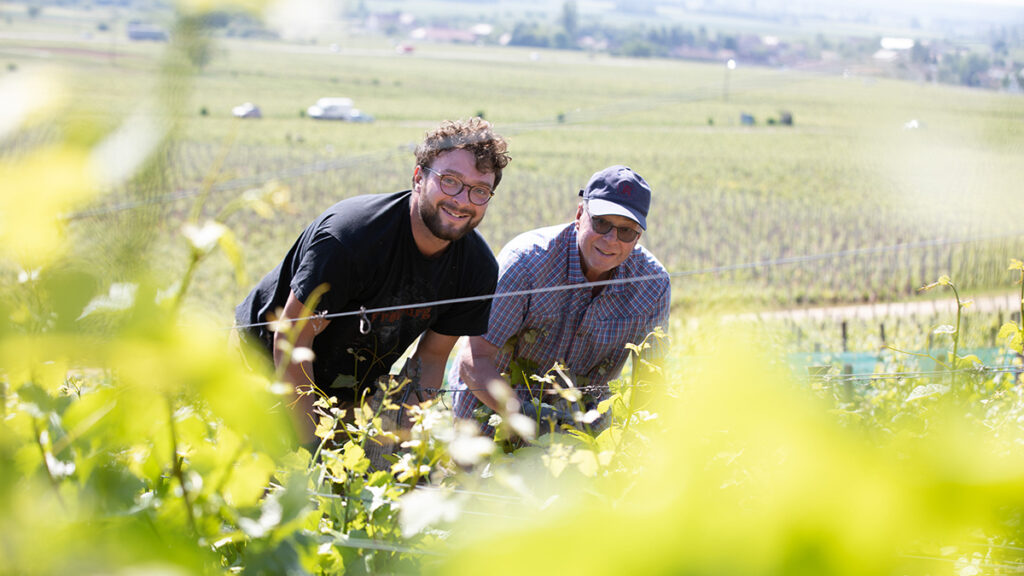

AMIOT Bourgogne rouge 2023: $395 Morey-St-Denis 1er “Charmes” 2023*: $1,095 Clos de la Roche Grand Cru 2023*: $3,540 NOTE: Wines marked with a * are available by the quarter case
(case prices)
Morey-St-Denis 2023: $795
Morey-St-Denis 1er “Ruchots” 2023*: $1,195
Gevrey-Chambertin 1er “Combottes” 2023*: $1,495
Pierre Vessigaud
Pouilly-Fuissé, Burgundy
When we lived in the Maconnais back in 1999, we discovered Michel Forest, a producer of Pouilly-Fuissé who showed us that great white Burgundy could be made an hour south of the Côte d’Or. Tasting his wines blind, sommeliers at Paris restaurants had guessed them to be Chassagne premier cru, and that was a reasonable guess. Ever since his retirement we have been looking for a comparable talent, and we may have found it in Pierre Vessigaud. We have worked with the Domaine Vessigaud for just a few vintages, but we see the same knack for making the most of the clay-limestone terroir that underlies Pouilly-Fuissé’s possibilities. The appellation is a bit sunnier than the Côte d’Or, but it has the capacity to rival its more famous neighbors to the north. Vessigaud is Demeter certified (the highest Biodynamic level), and the results in the glass are obvious: vibrant wines full of tension and bursting with life. We are not alone in our views — as William Kelley writes: “succulent but serious, any bottle bearing Vessigaud’s label is worth seeking out.” We begin with two regional level wines, both priced in the twenties, and both showing the deft touch we have come to recognize at the Domaine. The Macon Solutre-Pouilly 2023 comes from a plot in Pouilly, along the line between the hamlets of Pouilly and Fuissé. The Vessigauds vinify and raise it in large oak foudres for eleven months, where micro-oxygenation develops density and flavor rather than any apparent oak. The 2023 is much like the 2022, which became the house white for many of our fans of white Burgundy. There is surprising depth and length for a wine of this pedigree, with pure Chardonnay fruit and excellent tension. The Macon-Fuissé “Les Taches” is from high up a hill just outside the Pouilly-Fuissé appellation. It’s both vinified and raised in 5-10 year old oak barrels, and while there’s no new oak this cuvée has the added weight and complexity of a more serious wine. The nose is gorgeous and floral; the mouth is rich and smooth and not a bit lacking in acidity. It’s a nice counterpoint to the totally unoaked Macon-Solutré-Pouilly – richer and longer but no less fresh. It well overperforms its appellation, and we think of it as a baby Pouilly-Fuissé. From the village of Pouilly-Fuissé itself there are two fine choices. The Pouilly-Fuissé “Vieilles Vignes” 2023 is the principal cuvée of the domaine, made from 20 small parcels scattered across the Fuissé part of the appellation. The vines range from 40 to 70 years old, face all four points of the compass, and grow in a variety of marl, clay and limestone soils. Elevage for this cuvée is 80% in larger, older, oak barrels, and 20% in concrete vats, all for 18 months. The result is a wine of excellent balance and complexity. A series of very hot days at the end of the 2023 growing season concentrated the grapes, both in freshness and ripeness, making this a big, well balanced Pouilly-Fuissé. This wine should drink well for many years, perhaps as long as eight. It will be a fine match for foie gras, free-range chicken, seafood, or just by itself as an aperitif. The other village-level wine is the charmingly named Pouilly-Fuissé “Pierres à Canards,” whose stones once reminded someone of ducks’ feet. It’s a small plot of 70 year-old vines in a higher section, and in 2023 the wine was impressively generous in the nose and round in the mouth. It was vinified and raised in barrels for 12 months, followed by 6 months en cuve. There’s a lot going on in this glass: great purity of fruit mingled with a mineral line, and much length on the palate. It’s a bit drier than the Vieilles Vignes – more savory, more saline, more serious – but no less tasty. Like the Vieilles Vignes, it should have a long life and prove a versatile wine to pair with a wide range of dishes. The designation of Premier Crus in Pouilly-Fuissé was decades in the making, but effective with the 2020 vintage it finally arrived. The Vessigauds have two wines with the new designation, each showing the extra concentration, complexity and length of wine from the places that earned the title. Pouilly-Fuissé “Les Vignes Blanches” is from the lieu-dit Vers Agnières, an east-facing plot on Chouin limestone in the hamlet of Fuissé. The 2022 Vignes Blanches shows particular depth and richness, while at the same time offering excellent energy and freshness. In fact, we found the 2022 Vignes Blanches so compelling that we made an additional reservation and we are offering the 2022 again in this Futures offering. We’ve served this alongside premier crus from the Côte d’Or and it has more than held its own. This is a regal wine, with loads of lush fruit bolstered by delicate acidity. We’re delighted to find it still available with an extra year in the bottle, and look forward to enjoying it for many years to come. Pouilly-Fuissé 1er cru “Les Reisses” is from a marl and limestone plot called “Vers Pouilly,” also in the village of Fuissé. The vines here are between 60 and 80 years old — about twice as old as those in “Vignes Blanches.” Such vines make a lot of millerandage (grapes of various sizes that have a high skin-to-juice ratio), which produces concentrated wine of greater power and length. Elevage here is leisurely, with 12 months in 5 year old demi-muids (600L barrels) followed by six months in stainless steel. Persistence on the palate is particularly noteworthy in “Les Reisses” 2023, and its prominent mineral line carries through to the end. This is a focused and precise wine, more reminiscent of a Puligny-Montrachet than a Chassagne-Montrachet. Yet there’s plenty of attractive ripe fruit on the palate as well, and we expect the wine to develop nicely over the coming five years or more.
Domaine Gautheron
Chablis, Burgundy
We are longtime buyers of Chablis, drawn by both its pricing and the chiseled, pure character of the wine. A warming world has opened possibilities for making Chablis that resembles the white Burgundies of the Côte d’Or, and most producers dip a toe (or a foot) in that water. But while Cyril Gautheron has begun to offer more cuvées with some barrel influence, no one is more successful at preserving the essential character of Chablis. As Master of Wine Jasper Morris wrote recently: “Cyril Gautheron is a superb producer making wines in a crisp cool classically Chablis style, which is now really quite hard to achieve in these warmer seasons.” We thought it unlikely that Cyril would have followed his extraordinary 2022s with another vintage like it, but the 2023s are every bit as good, and in some cases even better. We tasted the entire range during our Burgundy visit a few weeks ago, and the hardest task of this offering has been keeping the list to a manageable length. We begin with two village-level wines that reflect both styles of winemaking in Chablis. Chablis “Cuvée Emeraude” 2023 is purely in the classic style: entirely vat-raised, steely, and bursting with energy — the sort of wine that inspired the classic pairing of Chablis with oysters. Its fruit is pure, clean lemon and lime. The Kimmeridgian limestone soils in which the 30-40 year old vines grow deliver a mineral line to complement the fruit and add a finish of mouth watering salinity. Gautheron’s Chablis “Vieilles Vignes” 2023 offers smoother edges. It comes from vines nearly twice as old, and it’s raised two-thirds in stainless steel and one-third in barrels. This wine is made to be slightly richer and rounder, with a discreet hint of oak that rounds out the minerality without obscuring it. It succeeds beautifully, delivering an elegant wine that also has good supporting acidity. The Chablis premier cru “Vaucoupin” has many longtime friends among Ansonia’s clients. Raised entirely in stainless steel, it is particularly nice in 2023, offering a fine and delicate mouthfeel. The balance is particularly good, with freshness tied into a palate that nonetheless feels round and supple. In the nose, floral notes of acacia join the clean lemon fruit. Jasper Morris found “plenty of tension on the palate, discreet in the middle, a little richer at the finish. . . . Classy yet of medium body.” This is prototypical Chablis, and it wants for nothing. From the same plot, Cyril also makes an old-vine cuvée (Fourneaux Vieilles Vignes), and some of his exquisite 2022 is still available. These vines are in a sector of the vineyard with more clay in the soil, which gives it a fleshier, rounder character than Vaucoupin. Elevage is 85% in tank and 15% in barrel. Aromatically expressive, this wine offers orchard fruit – white peaches or plums – along with its citrus. The mineral line is subdued, but contributes to a long finish. Jasper Morris awarded four stars, calling it “a much bigger scale wine. . . . Very interesting, and typically right bank in style.” Jasper Morris awarded five stars (his highest rating) to two of Gautheron’s premier crus in the 2023 vintage, and we agree completely with his judgment. Like the 2022, Montmains premier cru “Vieilles Vignes” is exceptional in 2023. The balance is just beautiful, with good roundness in the mouth, plenty of freshness at the same time, and extraordinary persistence on the palate. The 80 year age of these vines has something to do with the exceptional results, but vinification also plays a part. For a part of this wine Cyril has used a 3500 liter wooden cuve tronconique (a cone lopped off at the top to make a truncated cone). It delivers micro-oxygenation without much movement of the lees, making the wine less focused and a bit more open. Whatever the impact of this mechanism, the results are great and the wine will grace any cellar to which it is added. The other five-star choice — Chablis premier cru “Homme Mort” 2023 — is of the most modern style in Gautheron’s range. From a south-facing plot in a sector of Fourchaume (the premier cru that lies on the right bank just downstream of the Grand Crus), the clay-heavy soils make for a wine of more opulence than usual. For this wine Cyril raised 50% in barrels, including some new oak. The result is an ample, rich wine that is nonetheless Chablisien in character. A note on the curious name: Dead Man. The origin is not clear, but some locals think it could refer to sarcophagi from the Merovingian epoch discovered nearby; others favor a less dramatic reference to “Orme Mort,” a dead elm tree that once marked the boundary of the sector. We invite you to choose whatever best suits the occasion when you pull the cork. This nears Grand Cru in complexity and depth, and we think provides tremendous value under $50.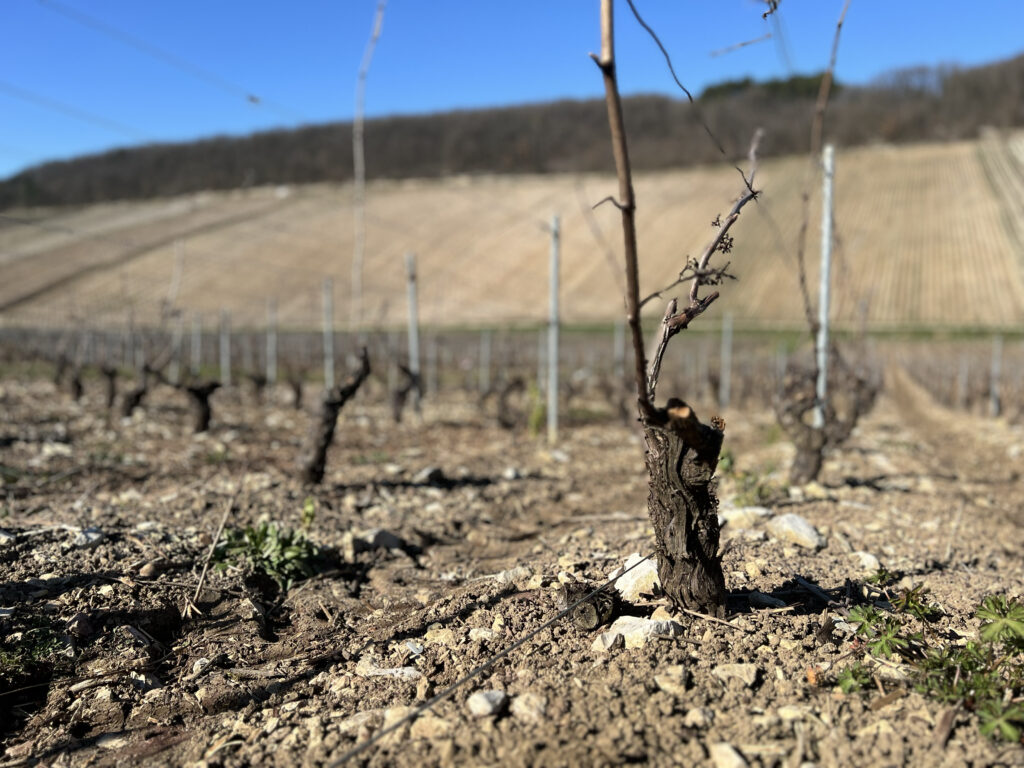
The Chablis premier cru “Fourneaux” 2023 is from a right-bank vineyard with more clay in the soils. It is also raised entirely in stainless steel, but the additional clay makes the wine more easily accessible, with a palate of rounder mouthfeel before a mineral finish with refreshing salinity. Jasper Morris awarded four stars, calling it “understated yet fine.”
Domaine Ragot
Givry, Burgundy
Last year we introduced Nicolas Ragot’s terrific Givrys to our portfolio, and they’ve been a real hit. Ragot is a thoughtful winemaker with a real innovative streak – he’s constantly refining his techniques, experimenting with amphoras, whole clusters, and even lighter weight bottles. He’s part of an exciting wave of winemakers pushing the limits on what’s possible from once humble appellations in the Côte Chalonnaise. Everyone’s favorite cuvée (including ours) last year was the Givry 1er cru Clos Jus, so we’re offering that one again this year. This is perhaps the best known vineyard in Givry, and it’s easy to see why – the soil has excellent drainage and unusually high iron oxide content. The resulting wines show a lovely balance of charming aromatics and refined mouthfeels. Ragot’s 2023 Clos Jus is terrific. It’s 85% raised in barrel (40% new) and the rest in amphora, with 25% whole cluster. This recipe makes for a serious red Burgundy, and the wine has the presence and texture of a village-level Gevrey-Chambertin. The nose is dark and sappy with impressively complex layers of spice, blackberry, cherry and stones. The mouth is rich and dense but with exceptional tension and freshness – it’s a dynamic wine in a way that much sub-$40 red Burgundy is not. Neal Martin of Vinous gave it 91 points, finding a “bouquet of crushed strawberry, cranberry and lightly pressed flower.” In the mouth he noted “fine tannins, well balanced and refined,” concluding “this is another delicious Givry from Nicolas Ragot.”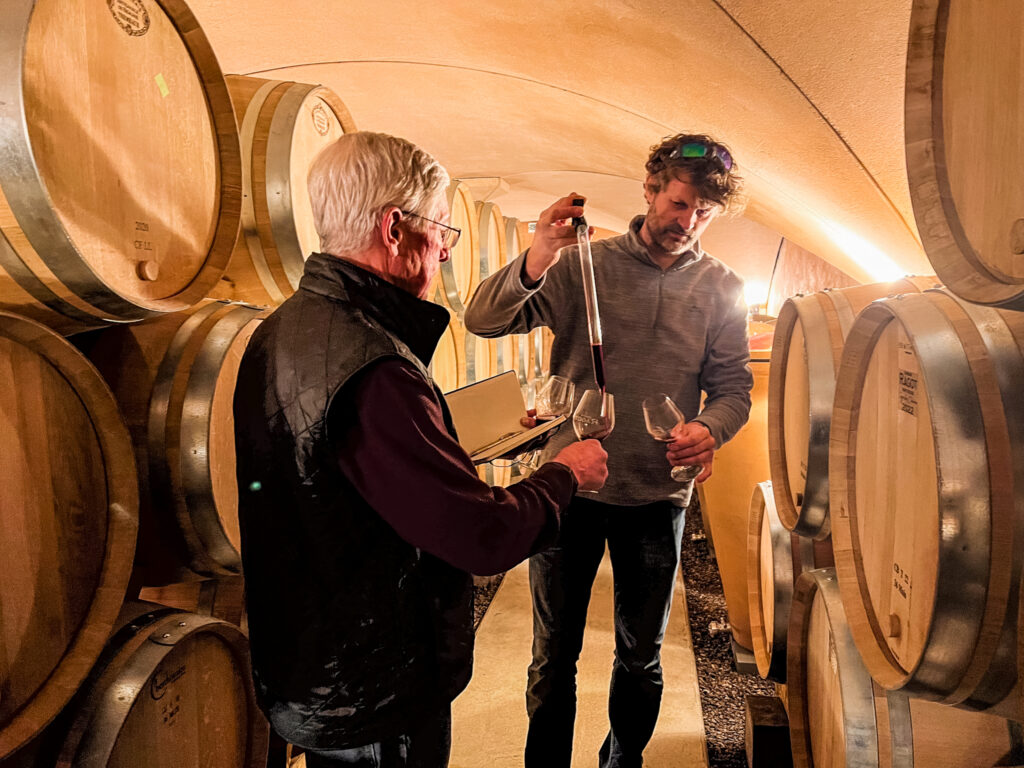

Domaine le Souverain
Sablet, France
We visited Eric Chauvin at his Domaine le Souverain in Sablet during our March trip. He has farmed organically for years, and always turns out well made, well priced village level wines, a step up from generic Côtes du Rhône. He opened the tasting with his Séguret 2023 “Classique,” a blend of equal parts Grenache and Syrah. This vintage is a particularly good one — it won Gold at the local concours d’Orange. We bought the 2023 last fall, so some of you still have it in your cellars. (We, on the other hand, have sold out.) But tasting it again in March, we were struck by just how well it is showing with a little more time in the bottle. The mouth is rich and full, and the dark fruit is even better integrated. We thought last year that this may be his best ever Seguret Classique, and the March tasting only added to that impression. Eric still has a little of the 2023 vintage left, so we reserved it on the spot. Our March tasting inspired us to make another reservation, this time of the Sablet 2022. Like the Seguret, this wine is entirely vat-raised. It is made from 55% Grenache and 30% Syrah, with the balance from Mourvedre. The Sablet 22 offers the same rich and round mouthfeel, but the Mourvedre adds a dark cherry tone to the fruit. Eric said that the Mourvedre “helps to hold the fruit,” and indeed the added complexity made the wine even more attractive. We’re not alone in being attracted to this wine — it was selected by the Guide Hachette, whose blind-tasting panels review thousands of wines every year.
Domaine Fontainerie
Vouvray, Loire Valley
We finally visited Catherine Dhoye-Deruet at the Domaine de la Fontainerie in Vouvray a few weeks ago, on our last day of tasting in the Loire Valley. Vouvray is in the central Loire, an area known for its Chenin Blanc planted in an unusual type of soft limestone called tuffeau. Like many in Vouvray, Catherine’s caves are carved into the tuffeau right below her vines – it’s a unique and remarkable place, and one that can produce terrific wines. Fontainerie’s wine list has three or four dozen wines available, going back into the 1980s. Vouvray is famous for its ability to age, particularly in cuvées with some residual sugar. We asked Catherine how she’d describe the longevity of her wines and she shrugged and said “well, eternal I suppose.” Indeed, decades old cuvées of Vouvray will still taste fresh and lively, a result of a high-acid grape (chenin blanc) and idiosyncratic soils. From an enormous list of wines we’ve chosen three favorites – one dry, one half-dry, and one sweet. First the Vouvray Sec 2022 – this is the second time we’re importing this wine, and it’s only gotten better. The nose is floral and pretty with notes of pears, dried apples, white flowers, and honey. The mouth is lively and full of tension, with no residual sugar to speak of and a long, sleek, mouthwatering finish. It’s classic dry Vouvray – pair with sushi, quiche, or a summer salad. Next, the off-dry. (We recognize we just lost most of our readers with those two words; if you’re still with us, good for you.) The 2016 Vouvray Demi-Sec was perhaps the most exciting wine at the Fontainerie tasting. At just 20g of residual sugar – compared with, say, 120g for Sauternes – this is barely sweet. In fact the splash of RS serves as just one element among many, along with a burst of stony freshness, clean acidity, and lush tropical fruit. With its near decade in the bottle, the fruit has developed into an extraordinary array of flavors, including raisins, dried mango, baked pear, yellow plum, and others unnamed / unknowable. But the end of the palate finishes with an elegant and vibrant tension. This wine has the sweetness of a lightly sweetened cocktail – think a Tom Collins or Whisky Sour – with the same acidity to balance. Our favorite food pairing for a wine like this is Asian with some spice – szechuan stir fry, thai or indian curry, etc. This won’t become your next house white, but it’s a remarkable wine at an incredible price. Finally, for dessert, an exceptional 2009 Vouvray Moelleux. This is fully sweet at 120g RS, but shot through with concentration and freshness. The nose shows plenty of botrytis, but with an orchard fruit bent compared to Sauternes’s citrus. The nose is remarkable, with notes of quince, saffron, apricot, and beeswax. The mouth is smooth and very long, lush and unctuous from the sugar but with clear definition and beautiful quiet tension. Serve this in place of dessert at the end of a fine meal.
2024 Rosés
Loire Valley, Chianti, Rhône Valley
Rosé season approaches! We’ve got three on offer this year, all low in alcohol, fresh and under $20/bottle. They cover three styles and origins – Italy, Loire, and Rhône Valley. (We’ll also note that these three caught an earlier boat, so will be available for shipping and pickup likely in early/mid May, ahead of the rest of the April Futures wines in this issue.) First, Domaine Sanzay’s 2024 Saumur Rosé is pure Cabernet Franc from the central Loire Valley. This popular cuvée is as good as ever, with a fresh strawberry nose and crisp, dry mouthfeel. At 12.3% alcohol this is a perfect wine for hot summer afternoons, whether pool, patio or picnic. Serve with nothing at all, or with goat cheese on crackers. Next up, Poggerino’s 2024 Rosato – a pure sangiovese rosé with excellent definition. It offers lively freshness, attractive fruit and at 12.5% alcohol just the right weight. The nose is drier than the Sanzay, with stony freshness and dried rose petal notes. Serve with a caprese salad or grilled vegetables dressed in good olive oil. Finally, Malmont’s 2024 Séguret Rosé. This is 90% grenache and 10% syrah, and as with all of Nicolas Hanei’s wines, impeccably balanced. Rosé from the Rhône Valley is always among our favorites, where savory notes of the rugged southern grapes blend beautifully with fruit and aromatics. The 2024 is smooth and fresh (13% alcohol), and has a gorgeous nose of wild cherries and melon. The mouth is clean and crisp with a faint note of grapeskin and a burst of stony freshness. Serve with chicken or summer vegetables on the grill.
_____________________________ If you have any trouble submitting the new order form, you can always email us your order. Or give us a call with questions: 617-249-3657, or tom@ansoniawines.com The deadline to place orders for this issue is: SUNDAY, APRIL 20. Questions? Need advice? Call us: (617) 249-3657. OPTIONS FOR GETTING YOUR ORDERS Pick-up near Philadelphia. Wines ordered for PA pickup will be available in the winter/spring, depending on temperatures. Email us for more details. Shipping elsewhere. In most states we can arrange for shipping at an additional cost that varies by location ($3.50 per bottle to the addresses west of Chicago; $2.50 per bottle east of Chicago). If shipping interests you, let us know the state and we will figure out if it can be done.
We expect these wines in June 2025
Pick-up in Massachusetts. We store our inventory at our new warehouse in Newton: 12 Hawthorn St, Newton MA 02458. Futures customers can pick up their orders here during Saturday open hours, or by appointment.

